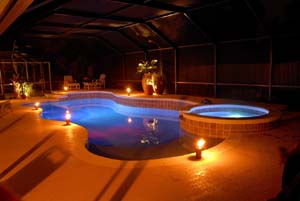The Best DIY Way to Get Rid of Pool Algae
By Kristen Swope
Anyone who’s ever owned a swimming pool has likely encountered that slimy greenish tint floating on the water’s surface or stubbornly attached to the pool’s walls and floor called algae. Having algae in a pool means several things, and none of them are attractive or healthy. For one thing, an algae-infested pool is nearly as uninviting as swimming in shark-infested waters not just because of how murky it looks, but also because of the unseen but apparent danger it poses. Thick algae make it difficult to detect potentially harmful debris and other things underwater that can injure a swimmer. Also, the presence of algae indicates that the pool water contains E. coli, a type of bacteria whose certain strains can cause gastroenteritis and UTI.
Algae should go away so people can enjoy their swimming pools to the fullest. For some pool owners, calling on the services of professional cleaners is the ultimate solution, but those who are on a pool maintenance budget can simply consider the following steps to make their swimming pools algae-free and crystal clear.
- Thoroughly clean the filters and scrub the pool walls.
These steps are very important especially for pool owners who have left their swimming pools for a long time to accumulate a very thick layer of algae so that the water is hardly visible. For extremely murky pools there is no other resort but to totally drain it, and then scrub the acrylic pool walls and floor to get rid of every last trace of algae so they won’t re-attach themselves to surfaces and flourish any time soon. Use a tile brush for tiled swimming pools, and a scrub brush with nylon bristles for fiberglass or vinyl pools. Clean out the pool’s filters very well to ensure a good flow by removing the entire grid and then scrubbing it off carefully and hosing it clean. If a pool vacuum is available, use it to clear out the pool’s bottom of dead bugs, dirt, and other pool debris before they permanently stain the floor or cause injury.
- Balance the water and shock your pool.
A water testing kit can be used to test the pool’s chemical levels and its alkalinity. Too much alkaline can actually stain a pool, while too much chlorine can cause eye and skin irritation to swimmers. Pool water’s appropriate pH level falls within the 7.2 to 7.6 range and alkalinity between 80-120 ppm because this where added chlorine is most efficient at keeping algae at bay. Anything higher can render chlorine shocking useless. Balancing pool water is an important preliminary to totally getting rid of algae because the very presence of algae means both the alkaline and pH levels of the pool are off. Administer an appropriate dose of chlorine shock to the pool based on the manufacturer’s instructions, or with the advice of a professional pool maintenance person to get the desired effect. After making sure that the filters are working fine, leave the chlorine-treated pool for at least 24 hours.
- Re-check pool water conditions and signs of dead algae.
After the 24 hour mark, test the pool water for balance once more. Dead algae turns a grayish color and can either float on the water’s surface or settle on the pool floor. Check for any remaining green algae because this needs to be completely zapped. If there are any left, a second dose of chlorine shocking might be needed. Repeat the process until all traces of live algae are eliminated.
- Vacuum up the dead algae and clean the pool’s filter once more.
Use the pool vacuum once more to pick up every last bit of dead algae and remaining debris without wreaking havoc on the pool filter. Backwash the pool filters so they can work in the best capacity and prevent algae from returning too quickly. Make it a weekly habit to test the pool water’s chemical balance to keep track of the possibility of another unwanted algae infestation.
Also, the blog loads extremely quick for me on Safari. Exceptional Blog Sildenafil Ed Pillen! Bestellen Sie jetzt unter view. In unserem Online-Shop generika nur bew€Ahrte Produkte von den besten Herstellern.
Filed under: Pool Maintenance
Like this post? Subscribe to my RSS feed and get loads more!










